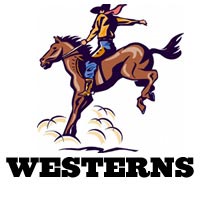Sam Peckinpah:
 Targeted
marketing strategies succeeded in highlighting certain special features or
sub-genres of western films. In the 1960s, two very different filmmakers refashioned
the western in new ways - Sam Peckinpah and Sergio Leone. In only his second
feature film, director Sam Peckinpah brought together two aging and admired
iconic western stars, Randolph Scott (in his last movie) and Joel McCrea as
two ex-lawmen transporting a gold shipment in the simply-told classic Ride
the High Country (1962), an evocative film about the passing of the old
West and the difficulty of adapting to changing times at the turn of the century.
The movie’s most quoted line was paraphrased from the Book of Luke: "All
I want is to enter my house justified." The friendship of the older heroes
was sorely tested by a younger hotshot gunslinger Heck Longtree (Ron Starr)
during their 4-day trip to a mining camp in the high Sierras. This was Peckinpah's
transition film from TV to big screen westerns. Targeted
marketing strategies succeeded in highlighting certain special features or
sub-genres of western films. In the 1960s, two very different filmmakers refashioned
the western in new ways - Sam Peckinpah and Sergio Leone. In only his second
feature film, director Sam Peckinpah brought together two aging and admired
iconic western stars, Randolph Scott (in his last movie) and Joel McCrea as
two ex-lawmen transporting a gold shipment in the simply-told classic Ride
the High Country (1962), an evocative film about the passing of the old
West and the difficulty of adapting to changing times at the turn of the century.
The movie’s most quoted line was paraphrased from the Book of Luke: "All
I want is to enter my house justified." The friendship of the older heroes
was sorely tested by a younger hotshot gunslinger Heck Longtree (Ron Starr)
during their 4-day trip to a mining camp in the high Sierras. This was Peckinpah's
transition film from TV to big screen westerns.
Peckinpah made his biggest impact on the evolution of the
Western with his Hollywood production of The Wild Bunch (1969), one of the best Westerns ever made - and
filmed during the height of the Vietnam War. It was an end-of-the-frontier
western set in Mexico in 1913 that followed the exploits of a band of outlaws
whose past way of life was slowly being overtaken by mechanization and urbanization
(symbolized by the technological inventions flaunted by a brutal Mexican guerrilla
leader). Peckinpah's masterpiece was marked with bloody, slow-motion, ultra-violent
choreographed ballets of death in its opening and in its finale when the group
decides to die. The revolutionary film was a precursor to urban crime thrillers
and inner-city gunfighting of the 1970s and later, and was often interpreted
as an allegory about the Vietnam War. [Since then, it has inspired dozens
of film-makers, including Quentin Tarantino and John Woo.] Peckinpah's revisionist Pat Garrett and Billy the Kid (1973) starred James Coburn as sheriff
Garrett who tracked down and killed ex-partner/outlaw Billy the Kid (Kris
Kristofferson).
Sergio Leone's 'Spaghetti' Westerns:
Italian director Sergio Leone brought many profound changes
with his trio of low-budget "spaghetti" western films made
in Europe (Spain and Italy) in the mid-60s, but not released in the US
until 1967. They were representative of a sub-genre of foreign-made films
featuring American stars (i.e., Clint Eastwood, Henry Fonda). The
changes included a new European, larger-than-life visual style, a
harsher, more violent and rough depiction of frontier life, revenge-seeking
bandits and bounty hunters, haunting and jarring music from Ennio
Morricone, choreographed gunfights, and wide-screen closeups.
TV's Rawhide (Rowdy Yates) star
Clint Eastwood was portrayed as the mysterious, detached, amoral, fearless
and cynical gunfighter and bounty hunter (dusty, serape-clad, stubbly-faced,
and cigar-chewing) - 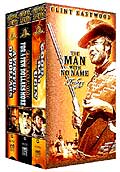 'The
Man With No Name.' [There were resemblances between Eastwood's characterization
and Alan Ladd's gunslinger in Shane
(1953).] 'The
Man With No Name.' [There were resemblances between Eastwood's characterization
and Alan Ladd's gunslinger in Shane
(1953).]
The trio of films that demythologized the Old West actually
resulted in a revival of the genre in the mid-to-late 1960s:
- A Fistful of Dollars (1964), with a plot borrowed
from Akira Kurosawa's samurai warrior classic Yojimbo (1961) and
from Dashiell Hammett's crime novel Red Harvest; the film inspired Walter Hill's gangster film remake Last Man Standing (1996) starring Bruce Willis
- For a Few Dollars More (1965)
- The Good, the Bad, and the Ugly (1966) - the best
and most ambitious film in the trilogy - the story of a quest for a cache
of hidden Confederate gold by three uneasily allied, gritty characters:
Clint Eastwood (the good), Lee Van Cleef (the bad), and Eli Wallach (the
ugly)
The director's true western epic masterpiece was Once
Upon a Time in the West (1968, It.), filmed in John Ford's favored
location, Monument Valley. It starred American icon-actor Henry
Fonda as its black, villainous murderer, and brought together all
the themes, characterizations, and experimental visuals from his
previous three films. [The only other film that featured Henry Fonda
in a rare villainous role was in Vincent McEveety's Firecreek
(1968).]
Clint Eastwood:
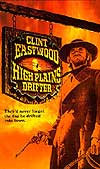 During
John Wayne's closing years, his popularity in westerns was matched only by
Clint Eastwood, who had graduated from CBS-TV's Rawhide (from 1959-1966
playing the character of Rowdy Yates) to Italian "spaghetti" westerns and
was brought to Hollywood to star in American westerns, first as an actor and
then as director (or actor/director). Eastwood developed and broadened his
range by appearing in director Ted Post's violent revenge western Hang
'Em High (1968), Eastwood's first American film as the star - a
film co-produced with his own production company Malpaso. Also, in the late
60's, he began his collaborative association with producer/director Don Siegel
by appearing in the action cop film Coogan's Bluff (1968) - a foreshadowing
of his performances as Dirty Harry. During
John Wayne's closing years, his popularity in westerns was matched only by
Clint Eastwood, who had graduated from CBS-TV's Rawhide (from 1959-1966
playing the character of Rowdy Yates) to Italian "spaghetti" westerns and
was brought to Hollywood to star in American westerns, first as an actor and
then as director (or actor/director). Eastwood developed and broadened his
range by appearing in director Ted Post's violent revenge western Hang
'Em High (1968), Eastwood's first American film as the star - a
film co-produced with his own production company Malpaso. Also, in the late
60's, he began his collaborative association with producer/director Don Siegel
by appearing in the action cop film Coogan's Bluff (1968) - a foreshadowing
of his performances as Dirty Harry.
High Plains Drifter (1973) was Eastwood's second film
as a director (and his first western as director), where he reprised his "The
Man with No Name" character from the "spaghetti" Western sub-genre. He also
directed and starred in the excellent revisionistic western epic The Outlaw
Josey Wales (1976), (Eastwood's fifth as a director and eighth true Western)
- one of his best films in which he portrayed a vengeful hero in pursuit of
a villainous Unionist Red Leg soldier. He went on to star as a Wild West Show
impresario in Broncho Billy (1980) (often not counted as a western),
and as a mysterious Preacher in Pale Rider (1985) - a film that was inspired by his earlier High Plains Drifter (1973).
 Although
it was thought that Westerns were experiencing their swan song in the late
1970s and 1980s, Eastwood's award-winning and compelling film Unforgiven
(1992) became the third western ever to win the Best Picture award.
Starring in his 10th western (in addition to producing and directing), Eastwood
played the part of William Munny - a retired, once-ruthless outlaw forced
to return to harsh violence in a bounty hunt against corrupt sheriff Little
Bill Daggett (Gene Hackman) in the town of Big Whiskey. The film de-mythologized
elements in the Western genre. Although
it was thought that Westerns were experiencing their swan song in the late
1970s and 1980s, Eastwood's award-winning and compelling film Unforgiven
(1992) became the third western ever to win the Best Picture award.
Starring in his 10th western (in addition to producing and directing), Eastwood
played the part of William Munny - a retired, once-ruthless outlaw forced
to return to harsh violence in a bounty hunt against corrupt sheriff Little
Bill Daggett (Gene Hackman) in the town of Big Whiskey. The film de-mythologized
elements in the Western genre.
Big Stars in Westerns:
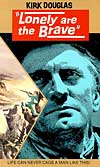 Title
roles for big box-office stars in westerns that rewrote the genre
were often among the greatest box-office successes. Kirk Douglas starred
in the modern cult western Lonely Are The Brave (1962), as
"Jack" Burns - a rugged, individualistic 'last cowboy' who rides through
contemporary-day New Mexico, cuts down fences, and is later pursued
on his horse Whiskey by police cars and helicopters led by conflicted
lawman Walter Matthau. Its adapted screenplay by blacklisted award-winning
Dalton Trumbo was taken from Edward Abbey's novel The Brave
Cowboy: An Old Tale in a New Time. And aging actor Clark Gable
and a burned-out Marilyn Monroe starred together in director John
Huston's haunting, modern-day western The Misfits
(1961) - the last film for the two stars. Title
roles for big box-office stars in westerns that rewrote the genre
were often among the greatest box-office successes. Kirk Douglas starred
in the modern cult western Lonely Are The Brave (1962), as
"Jack" Burns - a rugged, individualistic 'last cowboy' who rides through
contemporary-day New Mexico, cuts down fences, and is later pursued
on his horse Whiskey by police cars and helicopters led by conflicted
lawman Walter Matthau. Its adapted screenplay by blacklisted award-winning
Dalton Trumbo was taken from Edward Abbey's novel The Brave
Cowboy: An Old Tale in a New Time. And aging actor Clark Gable
and a burned-out Marilyn Monroe starred together in director John
Huston's haunting, modern-day western The Misfits
(1961) - the last film for the two stars.
 Paul
Newman starred in the anti-western Hud (1963) and Hombre
(1967),
and with Robert Redford in George Roy Hill's revisionistic and mildly
entertaining Butch Cassidy and the Sundance
Kid (1969) as
two light-hearted, amiable bank robbers - glamorous members of the legendary
'Hole-in-the-Wall' Gang, who were sought by a relentless posse and
fled to Bolivia with an adventurous schoolteacher to become 'Yanqui
banditos.' The entertaining film was enhanced by Burt Bacharach's
musical score. Like The
Wild Bunch (1969), the two are threatened by encroaching civilization
- here symbolized by a bicycle, and both meet their destined fate
when massacred by a Bolivian army - in freeze-frame. From its seven
nominations, the popular film won four Academy Awards and was the
highest-grossing western in film history up to that time. Charlton
Heston played the title role in director Tom Gries' Will Penny
(1968) of a fading and aging Western saddle tramp
- an exceptional film about the passing of the West. Paul
Newman starred in the anti-western Hud (1963) and Hombre
(1967),
and with Robert Redford in George Roy Hill's revisionistic and mildly
entertaining Butch Cassidy and the Sundance
Kid (1969) as
two light-hearted, amiable bank robbers - glamorous members of the legendary
'Hole-in-the-Wall' Gang, who were sought by a relentless posse and
fled to Bolivia with an adventurous schoolteacher to become 'Yanqui
banditos.' The entertaining film was enhanced by Burt Bacharach's
musical score. Like The
Wild Bunch (1969), the two are threatened by encroaching civilization
- here symbolized by a bicycle, and both meet their destined fate
when massacred by a Bolivian army - in freeze-frame. From its seven
nominations, the popular film won four Academy Awards and was the
highest-grossing western in film history up to that time. Charlton
Heston played the title role in director Tom Gries' Will Penny
(1968) of a fading and aging Western saddle tramp
- an exceptional film about the passing of the West.
One of the few attempts to portray Native-American life
in a more sympathetic light was found in the realistic depiction of
Sioux Indians in the Dakotas in A Man Called Horse (1970) with
Richard Harris. The British-financed western Hannie Caulder (1971),
starring Raquel Welch and Robert Culp, was both a rape-vengeance Western
and a comedy. Sexual frankness and gritty authenticity brought audiences
to Robert Altman's McCabe
& Mrs. Miller (1971) with Warren Beatty and Julie Christie partnering
as an entrepreneurial hustler and a opium-addicted brothel madam respectively.
Altman also debunked western myths in his ironic and politically-subversive Buffalo
Bill and The Indians (or Sitting Bull's History Lesson) (1976) released
in the Bi-Centennial year, with Paul Newman as the deconstructed, star-worshipped,
mythical figure of show-biz huckster and entrepreneur William F. Cody.
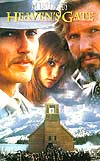 By
the end of the 70s decade, John Wayne and many of the master Western film
directors of all time had passed away, including John Ford, Howard Hawks,
Henry Hathaway, Henry King, Raoul Walsh, and Delmer Daves. By
the end of the 70s decade, John Wayne and many of the master Western film
directors of all time had passed away, including John Ford, Howard Hawks,
Henry Hathaway, Henry King, Raoul Walsh, and Delmer Daves.
The Decline of Westerns in the 80s:
In the early 1980s, westerns began to seriously decline and
disappear from cinema screens with changes in public taste and as memories
of the trail-blazing past receded. The tiring, familiar presence of westerns
on television and the recognition that the way of life of native Americans
was practically annihilated in our past caused the downturn. Oscar-winner
Michael Cimino's multi-million dollar failure for United Artists, a detailed,
over-long epic western Heaven's Gate (1980), contributed to the genre's
weakening.
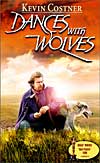 However,
in the mid 1980s and into the 90s, western films experienced something of
a comeback, due in part to the boost and the recognition received by two revisionistic,
Best Picture westerns: However,
in the mid 1980s and into the 90s, western films experienced something of
a comeback, due in part to the boost and the recognition received by two revisionistic,
Best Picture westerns:
- Dances with Wolves (1990), Kevin Costner's
politically-correct three-hour epic with twelve nominations and seven
awards
- Unforgiven (1992) with nine
nominations and four awards
Producer/actor Kevin Costner's box-office and critical success Dances with Wolves (1990), his directorial debut, was noted as one
of the few westerns that cast Indians in acting roles, used Lakota Sioux sub-titles,
and viewed Native Americans in a sympathetic way and not as blood-thirsty
savages. Although the film was officially sanctioned by the Sioux, not all
Native American groups were sympathetic to its portrayals.
Revisionist Westerns: Questioning and Rewriting
the Western
 The
genre had been reinvented, debunked, redefined and ridiculed, beginning
in the late 60s and early 70s. So-called 'revisionist' Westerns questioned
the themes and elements of traditional classics. Director
Sam Fuller's revisionist, low-budget B-film Run of the Arrow (1957),
often noted as similar to Costner's Dances With Wolves (1990) many
years later, starred Rod Steiger as a disheartened ex-Confederate soldier
who journeyed west, endured a torturous 'run of the arrow' challenge,
joined a Sioux Indian tribe, and fell in love with an Indian maiden
named Yellow Moccasin (Sarita Montiel, with her voice dubbed by Angie
Dickinson). John Ford's redemptive last western, Cheyenne
Autumn (1964) with
Richard Widmark and Carroll Baker, dealt with the destruction of the
Native-Americans, by portraying the forced, late 1880s westward exodus
of Cheyenne Indians from Oklahoma to their tribal lands in Wyoming. The
genre had been reinvented, debunked, redefined and ridiculed, beginning
in the late 60s and early 70s. So-called 'revisionist' Westerns questioned
the themes and elements of traditional classics. Director
Sam Fuller's revisionist, low-budget B-film Run of the Arrow (1957),
often noted as similar to Costner's Dances With Wolves (1990) many
years later, starred Rod Steiger as a disheartened ex-Confederate soldier
who journeyed west, endured a torturous 'run of the arrow' challenge,
joined a Sioux Indian tribe, and fell in love with an Indian maiden
named Yellow Moccasin (Sarita Montiel, with her voice dubbed by Angie
Dickinson). John Ford's redemptive last western, Cheyenne
Autumn (1964) with
Richard Widmark and Carroll Baker, dealt with the destruction of the
Native-Americans, by portraying the forced, late 1880s westward exodus
of Cheyenne Indians from Oklahoma to their tribal lands in Wyoming.
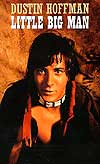 Dustin
Hoffman portrayed Jack Crabb - the sole, white, 121 year-old survivor of Custer's
Last Stand and the Battle of Little Big Horn in Arthur Penn's Little Big
Man (1970), a fable about the expansion of the Old West from an adaptation
of Thomas Berger's novel. [According to Guinness World Records, the
greatest age span portrayed by a movie actor, from 17 to 121, was by 33-year
old Hoffman for this role.] Paralleling the Vietnam tragedy, the film demythologized
the past and revealed the genocidal atrocities visited upon ethnic Indians
by US forces. Dustin
Hoffman portrayed Jack Crabb - the sole, white, 121 year-old survivor of Custer's
Last Stand and the Battle of Little Big Horn in Arthur Penn's Little Big
Man (1970), a fable about the expansion of the Old West from an adaptation
of Thomas Berger's novel. [According to Guinness World Records, the
greatest age span portrayed by a movie actor, from 17 to 121, was by 33-year
old Hoffman for this role.] Paralleling the Vietnam tragedy, the film demythologized
the past and revealed the genocidal atrocities visited upon ethnic Indians
by US forces.
A variety of other westerns re-fashioned western themes with
greater realism and less romantic and glamorous notions, such as:
- The Culpepper Cattle Co. (1972)
- two films about the James-Younger outlaw gang: Philip Kaufman's The Great Northfield, Minnesota Raid (1972) and maverick writer/director
Walter Hill's The Long Riders (1980) with actual siblings acting
as clan members
- Robert Aldrich's Vietnam allegory Ulzana's Raid
(1972), in which Burt Lancaster starred as crusty Indian
scout McIntosh involved in a search for escaped Chiracahua Apache
leader Ulzana (Joaquin Martinez) with a small band of braves from
the San Carlos Reservation that were terrorizing white settlers
- Lawrence Kasdan's big-budget Silverado (1985), featuring
a future all-star cast of then-unlikely Western actors including Kevin Kline,
Scott Glenn, Kevin Costner, Danny Glove, and John Cleese; a massive 1999
audience-participation Blockbuster Video poll named it "Most Deserving
of a Sequel"
- the contemporary western Young Guns (1988), with
a modern version of the Brat Pack in the lead roles
- Hill's Geronimo: An American Legend
(1993), a new look at native American Apache leader
Geronimo and his conflict with the US cavalry in the mid 1880s
- Tombstone (1993) (with Kurt Russell as Wyatt Earp
and Val Kilmer as the dying Doc Holliday)
- Wyatt Earp (1994) (with Kevin Costner in the title
role)
- and Walter Hill's Wild Bill (1995) with Jeff Bridges
as the legendary western frontier character, revealed in dreamy flashback
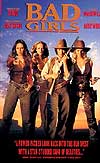 [The
exploits of Earp had already appeared in many previous Hollywood films including
Ford's My Darling Clementine (1946) (with Henry Fonda) and John Sturges' Gunfight at the OK Corral (1957) (with Burt Lancaster).] [The
exploits of Earp had already appeared in many previous Hollywood films including
Ford's My Darling Clementine (1946) (with Henry Fonda) and John Sturges' Gunfight at the OK Corral (1957) (with Burt Lancaster).]
Other post-classical, revisionist westerns in the mid-90s
featured the West from a feminist or African-American perspective such as The Ballad of Little Jo (1993) about an ostracized Eastern woman (Suzy
Amis) who moved west and disguised herself as a man, Bad Girls (1994) about four saloon prostitutes (Madeleine Stowe, Andie MacDowell, Mary Stuart
Masterson, and Drew Barrymore), "a star-studded gang of beauties"
who bonded together as gunslingers, and director Sam Raimi's 'spaghetti' western The Quick and the Dead (1995) that starred Sharon Stone as a vengeful
lady gunslinger - a female Clint Eastwood. Mario Van Peebles' exploitative,
exciting adventure-western Posse (1993) featured black cowboys and
revisionist, politically-correct western history.
Western Spoofs and Comedies:
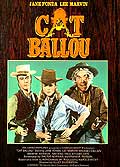 Western
parodies and comedies that mocked the genre include director Elliot
Silverstein's very successful spoof hit Cat Ballou (1965) (with
Jane Fonda in the title role, and with Lee Marvin in a dual, Best
Actor-winning role), and Mel Brooks' Blazing
Saddles (1974). James Garner (of TV's Maverick fame
of the late 1950s) starred in two western-spoofs in the period: director
Burt Kennedy's Support Your Local Sheriff! (1969) (that paid
homage to previous versions of Wyatt Earp's legendary 'Gunfight at
the OK Corral' and My Darling Clementine) and its lesser parody
sequel Support Your Local Gunfighter (1971). John Wayne appeared
in the western comedy McLintock! (1963), featuring a battle-of-the-sexes
"Taming of the Shrew" relationship between Wayne and Maureen
O'Hara, and including a serious, often-mentioned scene of McLintock
breaking up a Native-American lynching. Western
parodies and comedies that mocked the genre include director Elliot
Silverstein's very successful spoof hit Cat Ballou (1965) (with
Jane Fonda in the title role, and with Lee Marvin in a dual, Best
Actor-winning role), and Mel Brooks' Blazing
Saddles (1974). James Garner (of TV's Maverick fame
of the late 1950s) starred in two western-spoofs in the period: director
Burt Kennedy's Support Your Local Sheriff! (1969) (that paid
homage to previous versions of Wyatt Earp's legendary 'Gunfight at
the OK Corral' and My Darling Clementine) and its lesser parody
sequel Support Your Local Gunfighter (1971). John Wayne appeared
in the western comedy McLintock! (1963), featuring a battle-of-the-sexes
"Taming of the Shrew" relationship between Wayne and Maureen
O'Hara, and including a serious, often-mentioned scene of McLintock
breaking up a Native-American lynching.
Another 'western' comedy - City Slickers (1991) followed
a group of middle-aged buddies embarking on a two-week western cattle drive
led by a tough trail cowpoke named Curly (Jack Palance won a Best Supporting
Actor Oscar for the role). A big-screen, commercially-successful comedy-western, Maverick (1994), a spin-off from a late 50s and early 60s TV series,
starred Mel Gibson in the title role as card sharp Bret Maverick, and the
original Maverick character (James Garner) as Marshal Zane Cooper. Barry Sonnenfeld's The Wild Wild West (1999) was a spin-off from the popular mid-60's
TV spy show with Men in Black's Will Smith as James T. West and Kevin
Kline as Artemus Gordon. Tom Dey's old West spin-off Shanghai Noon (2000) featured kung-fu superstar Jackie Chan as Chon Wang - an obvious take-off
on John Wayne.
Other Variations on Westerns:
 A superb television miniseries, adapted
from Larry McMurtry's Pulitzer Prize-winning novel, was the classic western
saga Lonesome Dove (1989). The eight-hour, four-part miniseries by
director Simon Wincer starred Tommy Lee Jones and Robert Duvall as Gus McCrae
and Woodrow Call, two aging, cussing ex-Texas Rangers who engage in an adventurous
cattle drive over the 2,500 miles from Texas to Montana. [It produced further
mini-series sequels, Return to Lonesome Dove, Streets of Laredo,
and Dead Man's Walk.] A superb television miniseries, adapted
from Larry McMurtry's Pulitzer Prize-winning novel, was the classic western
saga Lonesome Dove (1989). The eight-hour, four-part miniseries by
director Simon Wincer starred Tommy Lee Jones and Robert Duvall as Gus McCrae
and Woodrow Call, two aging, cussing ex-Texas Rangers who engage in an adventurous
cattle drive over the 2,500 miles from Texas to Montana. [It produced further
mini-series sequels, Return to Lonesome Dove, Streets of Laredo,
and Dead Man's Walk.]
Westerns from a science-fiction point of view
included a western-style Back to the Future, Part III (1990). The low-budget Grim Prairie Tales (1990) was a supernatural horror-western - an anthology
of four scary, unbelievable tales told around an open prairie campfire. Jim
Jarmusch's metaphoric, unique, mystical black and white western Dead Man
(1996) starred Johnny Depp as an 1875 western wanderer (the ghost of poet
William Blake?) pursued by bounty-hunters. Kathryn Bigelow's western-noir
vampire-horror film Near Dark (1987) featured Bill Paxton and Lance
Henricksen as members of a ghoulish motorcycle gang in America's Southwest.
The Coen Brothers put their own spin on the role made famous by Oscar-winning John Wayne's 'Rooster' Cogburn, in the PG-13 adventure remake True Grit (2010), starring Jeff Bridges. It soon became the director duo's biggest hit, and the highest-grossing western since Wild Wild West (1999). |
